HSN708: University Students Nutrition Promotion Session Plan
VerifiedAdded on 2023/04/21
|14
|3670
|61
Report
AI Summary
This report presents a nutrition session plan designed for university students aged 18-25, focusing on promoting healthy eating habits within the university environment. The plan addresses key influences such as academic and peer pressure, convenience, lack of awareness, and socioeconomic factors that affect students' dietary choices. It incorporates behavior change theories, learning principles, and practical strategies to educate students on the importance of balanced nutrition, time management, and cost-effective meal preparation. The session plan includes educational resources, group activities, cooking sessions, and evaluation methods to measure outcomes and improve future interventions. The aim is to foster positive dietary behaviors and improve the overall health and well-being of university students.
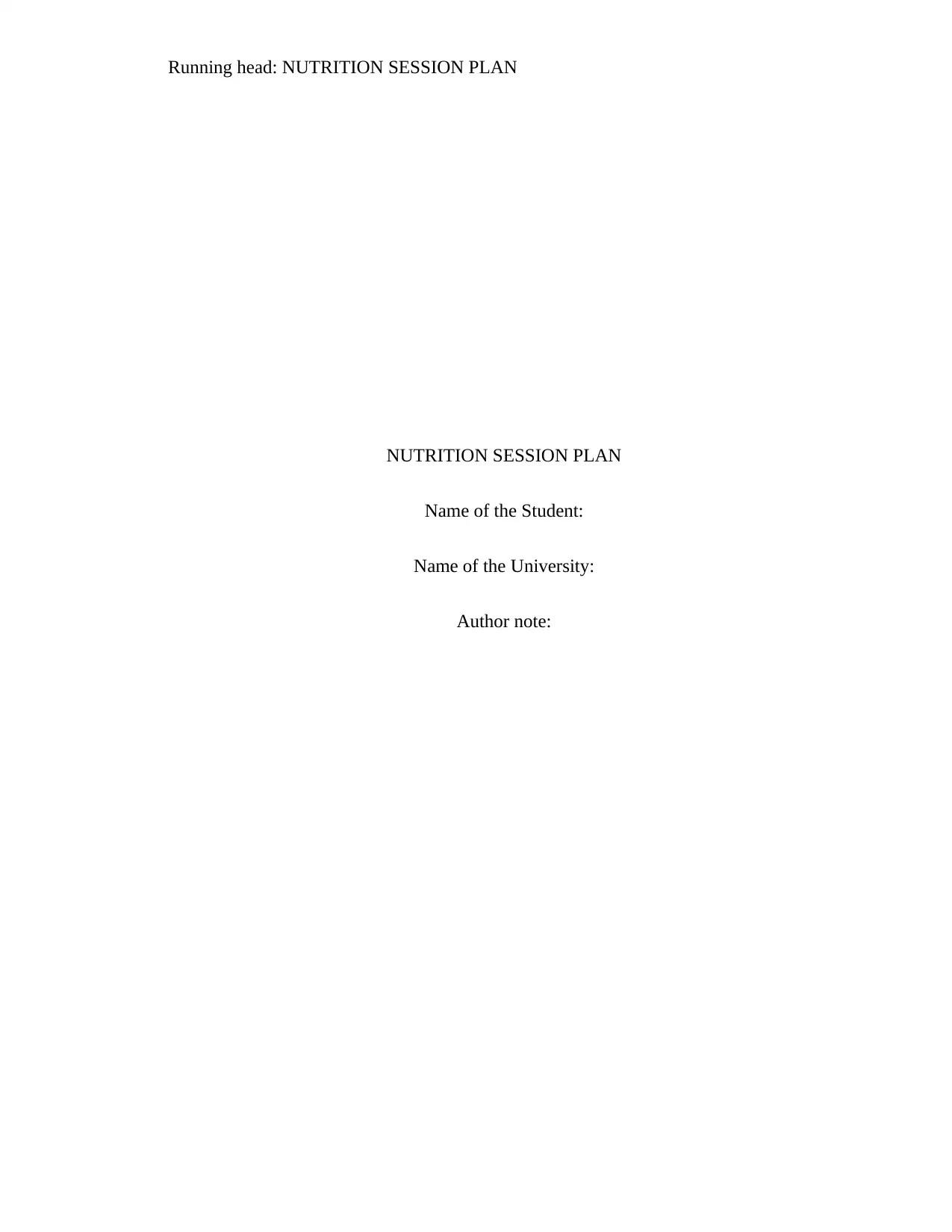
Running head: NUTRITION SESSION PLAN
NUTRITION SESSION PLAN
Name of the Student:
Name of the University:
Author note:
NUTRITION SESSION PLAN
Name of the Student:
Name of the University:
Author note:
Paraphrase This Document
Need a fresh take? Get an instant paraphrase of this document with our AI Paraphraser
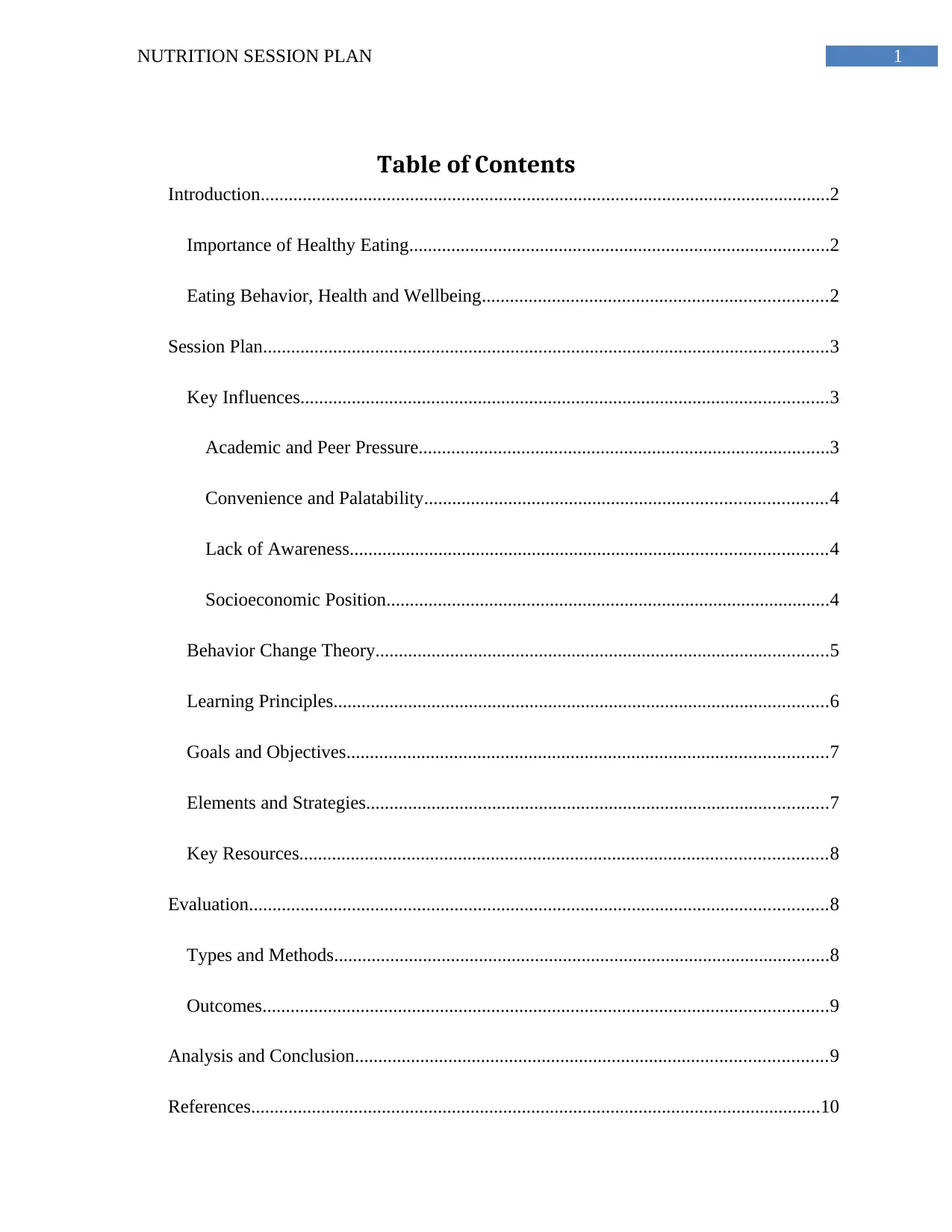
1NUTRITION SESSION PLAN
Table of Contents
Introduction..........................................................................................................................2
Importance of Healthy Eating..........................................................................................2
Eating Behavior, Health and Wellbeing..........................................................................2
Session Plan.........................................................................................................................3
Key Influences.................................................................................................................3
Academic and Peer Pressure........................................................................................3
Convenience and Palatability......................................................................................4
Lack of Awareness......................................................................................................4
Socioeconomic Position...............................................................................................4
Behavior Change Theory.................................................................................................5
Learning Principles..........................................................................................................6
Goals and Objectives.......................................................................................................7
Elements and Strategies...................................................................................................7
Key Resources.................................................................................................................8
Evaluation............................................................................................................................8
Types and Methods..........................................................................................................8
Outcomes.........................................................................................................................9
Analysis and Conclusion.....................................................................................................9
References..........................................................................................................................10
Table of Contents
Introduction..........................................................................................................................2
Importance of Healthy Eating..........................................................................................2
Eating Behavior, Health and Wellbeing..........................................................................2
Session Plan.........................................................................................................................3
Key Influences.................................................................................................................3
Academic and Peer Pressure........................................................................................3
Convenience and Palatability......................................................................................4
Lack of Awareness......................................................................................................4
Socioeconomic Position...............................................................................................4
Behavior Change Theory.................................................................................................5
Learning Principles..........................................................................................................6
Goals and Objectives.......................................................................................................7
Elements and Strategies...................................................................................................7
Key Resources.................................................................................................................8
Evaluation............................................................................................................................8
Types and Methods..........................................................................................................8
Outcomes.........................................................................................................................9
Analysis and Conclusion.....................................................................................................9
References..........................................................................................................................10
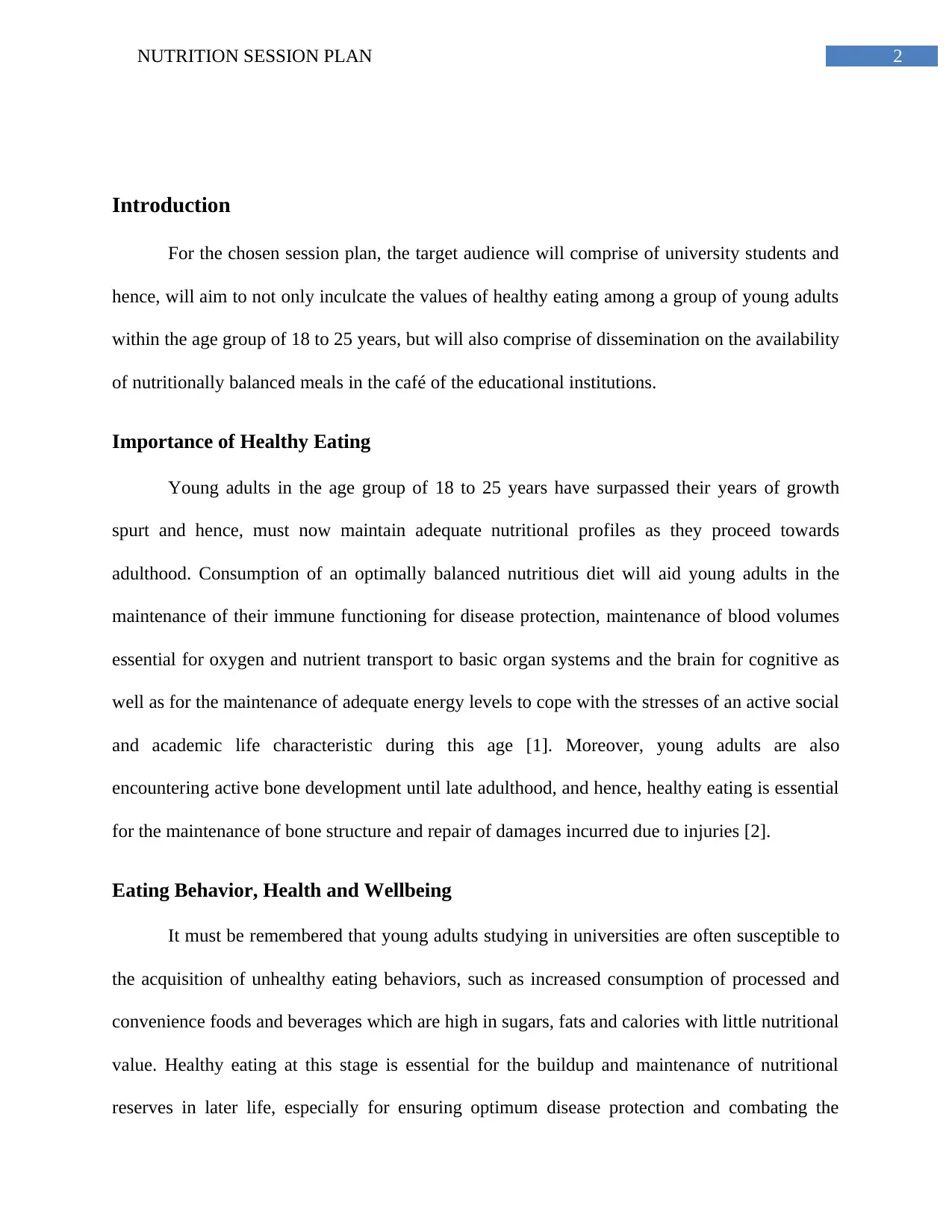
2NUTRITION SESSION PLAN
Introduction
For the chosen session plan, the target audience will comprise of university students and
hence, will aim to not only inculcate the values of healthy eating among a group of young adults
within the age group of 18 to 25 years, but will also comprise of dissemination on the availability
of nutritionally balanced meals in the café of the educational institutions.
Importance of Healthy Eating
Young adults in the age group of 18 to 25 years have surpassed their years of growth
spurt and hence, must now maintain adequate nutritional profiles as they proceed towards
adulthood. Consumption of an optimally balanced nutritious diet will aid young adults in the
maintenance of their immune functioning for disease protection, maintenance of blood volumes
essential for oxygen and nutrient transport to basic organ systems and the brain for cognitive as
well as for the maintenance of adequate energy levels to cope with the stresses of an active social
and academic life characteristic during this age [1]. Moreover, young adults are also
encountering active bone development until late adulthood, and hence, healthy eating is essential
for the maintenance of bone structure and repair of damages incurred due to injuries [2].
Eating Behavior, Health and Wellbeing
It must be remembered that young adults studying in universities are often susceptible to
the acquisition of unhealthy eating behaviors, such as increased consumption of processed and
convenience foods and beverages which are high in sugars, fats and calories with little nutritional
value. Healthy eating at this stage is essential for the buildup and maintenance of nutritional
reserves in later life, especially for ensuring optimum disease protection and combating the
Introduction
For the chosen session plan, the target audience will comprise of university students and
hence, will aim to not only inculcate the values of healthy eating among a group of young adults
within the age group of 18 to 25 years, but will also comprise of dissemination on the availability
of nutritionally balanced meals in the café of the educational institutions.
Importance of Healthy Eating
Young adults in the age group of 18 to 25 years have surpassed their years of growth
spurt and hence, must now maintain adequate nutritional profiles as they proceed towards
adulthood. Consumption of an optimally balanced nutritious diet will aid young adults in the
maintenance of their immune functioning for disease protection, maintenance of blood volumes
essential for oxygen and nutrient transport to basic organ systems and the brain for cognitive as
well as for the maintenance of adequate energy levels to cope with the stresses of an active social
and academic life characteristic during this age [1]. Moreover, young adults are also
encountering active bone development until late adulthood, and hence, healthy eating is essential
for the maintenance of bone structure and repair of damages incurred due to injuries [2].
Eating Behavior, Health and Wellbeing
It must be remembered that young adults studying in universities are often susceptible to
the acquisition of unhealthy eating behaviors, such as increased consumption of processed and
convenience foods and beverages which are high in sugars, fats and calories with little nutritional
value. Healthy eating at this stage is essential for the buildup and maintenance of nutritional
reserves in later life, especially for ensuring optimum disease protection and combating the
⊘ This is a preview!⊘
Do you want full access?
Subscribe today to unlock all pages.

Trusted by 1+ million students worldwide
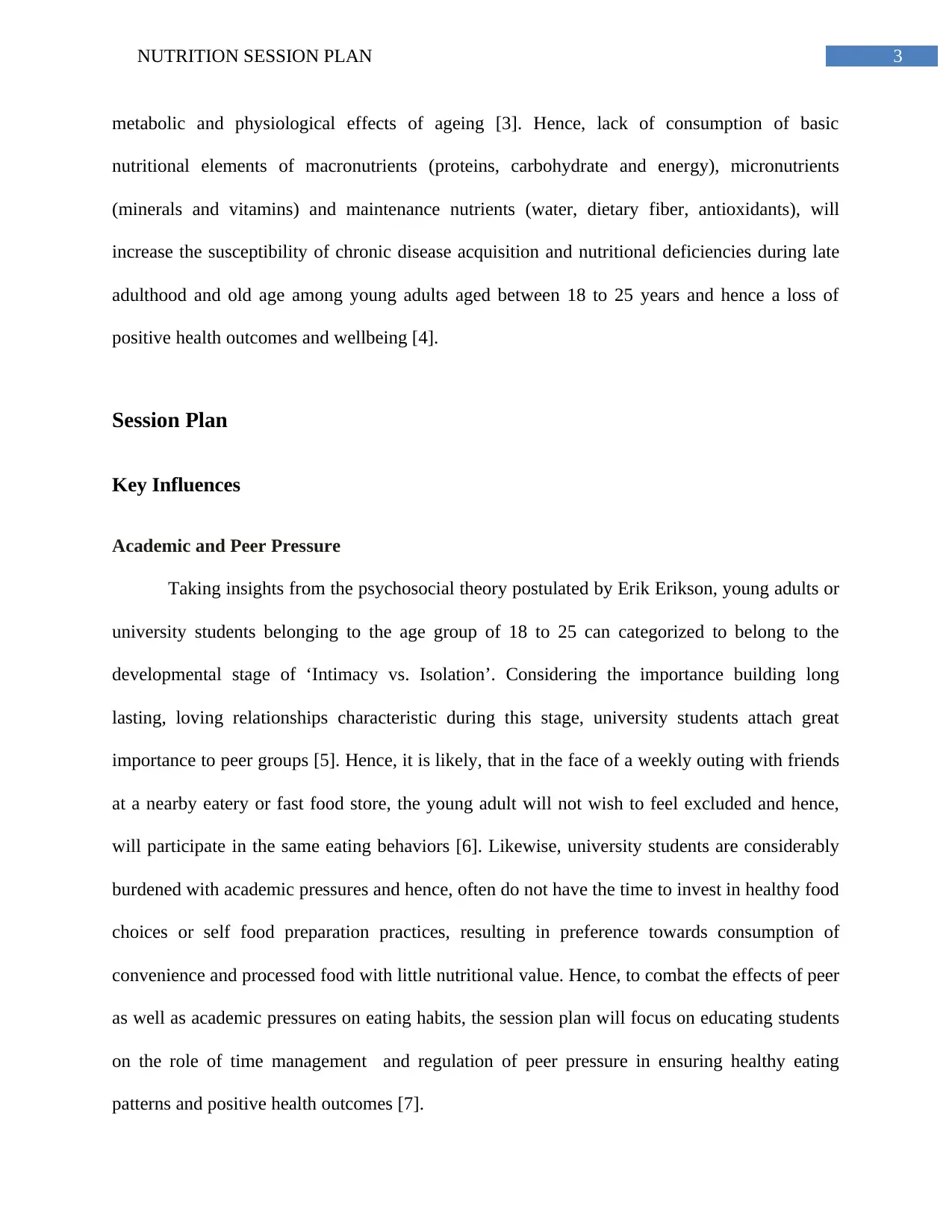
3NUTRITION SESSION PLAN
metabolic and physiological effects of ageing [3]. Hence, lack of consumption of basic
nutritional elements of macronutrients (proteins, carbohydrate and energy), micronutrients
(minerals and vitamins) and maintenance nutrients (water, dietary fiber, antioxidants), will
increase the susceptibility of chronic disease acquisition and nutritional deficiencies during late
adulthood and old age among young adults aged between 18 to 25 years and hence a loss of
positive health outcomes and wellbeing [4].
Session Plan
Key Influences
Academic and Peer Pressure
Taking insights from the psychosocial theory postulated by Erik Erikson, young adults or
university students belonging to the age group of 18 to 25 can categorized to belong to the
developmental stage of ‘Intimacy vs. Isolation’. Considering the importance building long
lasting, loving relationships characteristic during this stage, university students attach great
importance to peer groups [5]. Hence, it is likely, that in the face of a weekly outing with friends
at a nearby eatery or fast food store, the young adult will not wish to feel excluded and hence,
will participate in the same eating behaviors [6]. Likewise, university students are considerably
burdened with academic pressures and hence, often do not have the time to invest in healthy food
choices or self food preparation practices, resulting in preference towards consumption of
convenience and processed food with little nutritional value. Hence, to combat the effects of peer
as well as academic pressures on eating habits, the session plan will focus on educating students
on the role of time management and regulation of peer pressure in ensuring healthy eating
patterns and positive health outcomes [7].
metabolic and physiological effects of ageing [3]. Hence, lack of consumption of basic
nutritional elements of macronutrients (proteins, carbohydrate and energy), micronutrients
(minerals and vitamins) and maintenance nutrients (water, dietary fiber, antioxidants), will
increase the susceptibility of chronic disease acquisition and nutritional deficiencies during late
adulthood and old age among young adults aged between 18 to 25 years and hence a loss of
positive health outcomes and wellbeing [4].
Session Plan
Key Influences
Academic and Peer Pressure
Taking insights from the psychosocial theory postulated by Erik Erikson, young adults or
university students belonging to the age group of 18 to 25 can categorized to belong to the
developmental stage of ‘Intimacy vs. Isolation’. Considering the importance building long
lasting, loving relationships characteristic during this stage, university students attach great
importance to peer groups [5]. Hence, it is likely, that in the face of a weekly outing with friends
at a nearby eatery or fast food store, the young adult will not wish to feel excluded and hence,
will participate in the same eating behaviors [6]. Likewise, university students are considerably
burdened with academic pressures and hence, often do not have the time to invest in healthy food
choices or self food preparation practices, resulting in preference towards consumption of
convenience and processed food with little nutritional value. Hence, to combat the effects of peer
as well as academic pressures on eating habits, the session plan will focus on educating students
on the role of time management and regulation of peer pressure in ensuring healthy eating
patterns and positive health outcomes [7].
Paraphrase This Document
Need a fresh take? Get an instant paraphrase of this document with our AI Paraphraser
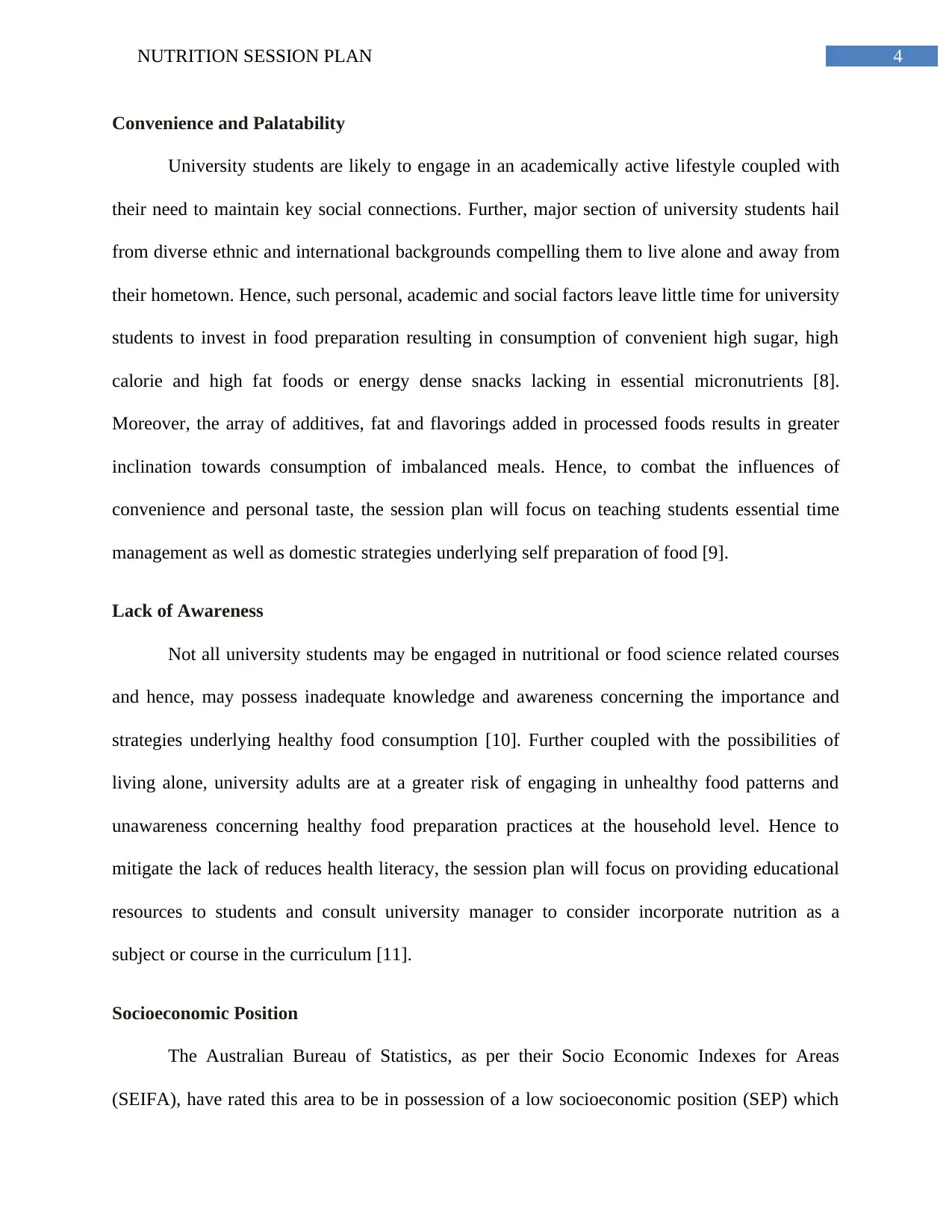
4NUTRITION SESSION PLAN
Convenience and Palatability
University students are likely to engage in an academically active lifestyle coupled with
their need to maintain key social connections. Further, major section of university students hail
from diverse ethnic and international backgrounds compelling them to live alone and away from
their hometown. Hence, such personal, academic and social factors leave little time for university
students to invest in food preparation resulting in consumption of convenient high sugar, high
calorie and high fat foods or energy dense snacks lacking in essential micronutrients [8].
Moreover, the array of additives, fat and flavorings added in processed foods results in greater
inclination towards consumption of imbalanced meals. Hence, to combat the influences of
convenience and personal taste, the session plan will focus on teaching students essential time
management as well as domestic strategies underlying self preparation of food [9].
Lack of Awareness
Not all university students may be engaged in nutritional or food science related courses
and hence, may possess inadequate knowledge and awareness concerning the importance and
strategies underlying healthy food consumption [10]. Further coupled with the possibilities of
living alone, university adults are at a greater risk of engaging in unhealthy food patterns and
unawareness concerning healthy food preparation practices at the household level. Hence to
mitigate the lack of reduces health literacy, the session plan will focus on providing educational
resources to students and consult university manager to consider incorporate nutrition as a
subject or course in the curriculum [11].
Socioeconomic Position
The Australian Bureau of Statistics, as per their Socio Economic Indexes for Areas
(SEIFA), have rated this area to be in possession of a low socioeconomic position (SEP) which
Convenience and Palatability
University students are likely to engage in an academically active lifestyle coupled with
their need to maintain key social connections. Further, major section of university students hail
from diverse ethnic and international backgrounds compelling them to live alone and away from
their hometown. Hence, such personal, academic and social factors leave little time for university
students to invest in food preparation resulting in consumption of convenient high sugar, high
calorie and high fat foods or energy dense snacks lacking in essential micronutrients [8].
Moreover, the array of additives, fat and flavorings added in processed foods results in greater
inclination towards consumption of imbalanced meals. Hence, to combat the influences of
convenience and personal taste, the session plan will focus on teaching students essential time
management as well as domestic strategies underlying self preparation of food [9].
Lack of Awareness
Not all university students may be engaged in nutritional or food science related courses
and hence, may possess inadequate knowledge and awareness concerning the importance and
strategies underlying healthy food consumption [10]. Further coupled with the possibilities of
living alone, university adults are at a greater risk of engaging in unhealthy food patterns and
unawareness concerning healthy food preparation practices at the household level. Hence to
mitigate the lack of reduces health literacy, the session plan will focus on providing educational
resources to students and consult university manager to consider incorporate nutrition as a
subject or course in the curriculum [11].
Socioeconomic Position
The Australian Bureau of Statistics, as per their Socio Economic Indexes for Areas
(SEIFA), have rated this area to be in possession of a low socioeconomic position (SEP) which
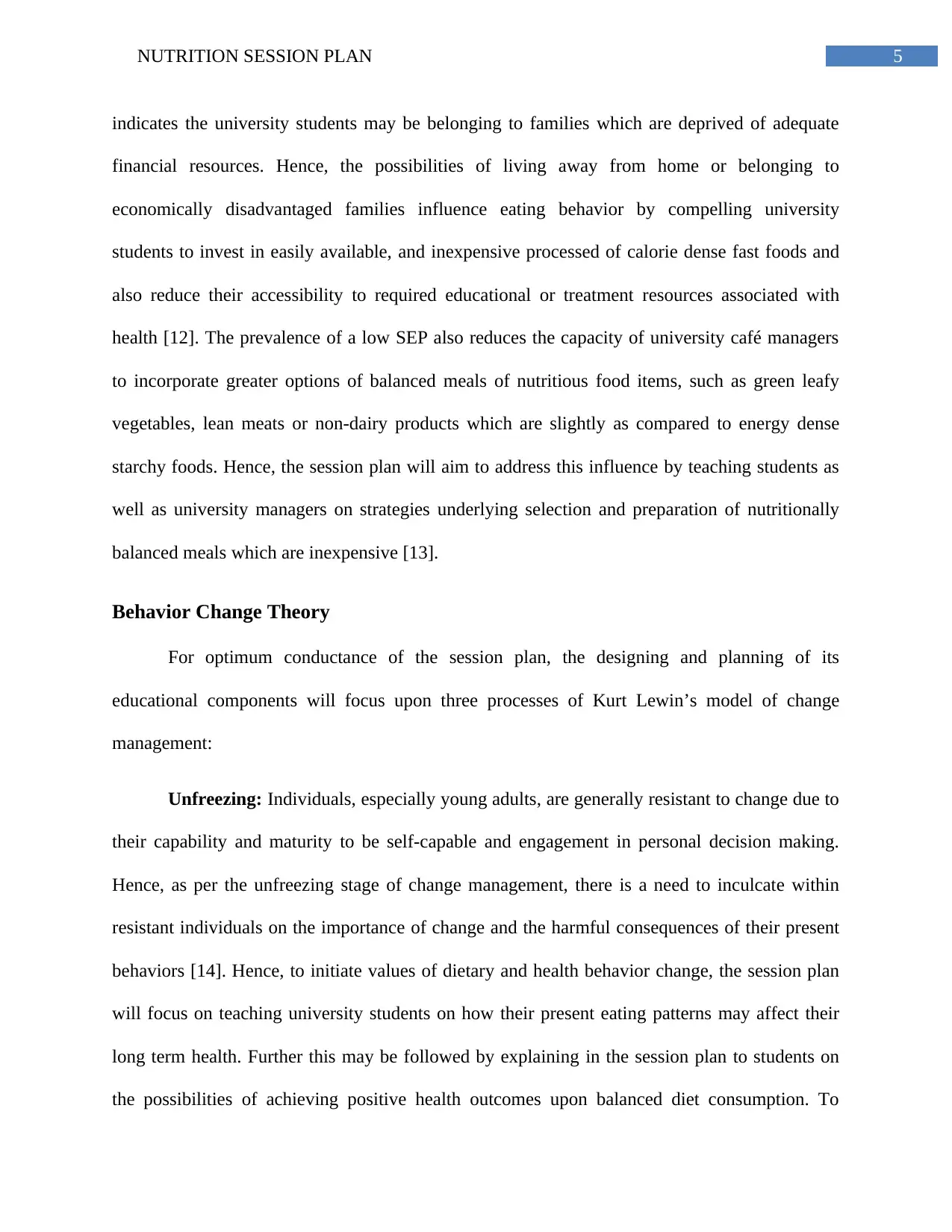
5NUTRITION SESSION PLAN
indicates the university students may be belonging to families which are deprived of adequate
financial resources. Hence, the possibilities of living away from home or belonging to
economically disadvantaged families influence eating behavior by compelling university
students to invest in easily available, and inexpensive processed of calorie dense fast foods and
also reduce their accessibility to required educational or treatment resources associated with
health [12]. The prevalence of a low SEP also reduces the capacity of university café managers
to incorporate greater options of balanced meals of nutritious food items, such as green leafy
vegetables, lean meats or non-dairy products which are slightly as compared to energy dense
starchy foods. Hence, the session plan will aim to address this influence by teaching students as
well as university managers on strategies underlying selection and preparation of nutritionally
balanced meals which are inexpensive [13].
Behavior Change Theory
For optimum conductance of the session plan, the designing and planning of its
educational components will focus upon three processes of Kurt Lewin’s model of change
management:
Unfreezing: Individuals, especially young adults, are generally resistant to change due to
their capability and maturity to be self-capable and engagement in personal decision making.
Hence, as per the unfreezing stage of change management, there is a need to inculcate within
resistant individuals on the importance of change and the harmful consequences of their present
behaviors [14]. Hence, to initiate values of dietary and health behavior change, the session plan
will focus on teaching university students on how their present eating patterns may affect their
long term health. Further this may be followed by explaining in the session plan to students on
the possibilities of achieving positive health outcomes upon balanced diet consumption. To
indicates the university students may be belonging to families which are deprived of adequate
financial resources. Hence, the possibilities of living away from home or belonging to
economically disadvantaged families influence eating behavior by compelling university
students to invest in easily available, and inexpensive processed of calorie dense fast foods and
also reduce their accessibility to required educational or treatment resources associated with
health [12]. The prevalence of a low SEP also reduces the capacity of university café managers
to incorporate greater options of balanced meals of nutritious food items, such as green leafy
vegetables, lean meats or non-dairy products which are slightly as compared to energy dense
starchy foods. Hence, the session plan will aim to address this influence by teaching students as
well as university managers on strategies underlying selection and preparation of nutritionally
balanced meals which are inexpensive [13].
Behavior Change Theory
For optimum conductance of the session plan, the designing and planning of its
educational components will focus upon three processes of Kurt Lewin’s model of change
management:
Unfreezing: Individuals, especially young adults, are generally resistant to change due to
their capability and maturity to be self-capable and engagement in personal decision making.
Hence, as per the unfreezing stage of change management, there is a need to inculcate within
resistant individuals on the importance of change and the harmful consequences of their present
behaviors [14]. Hence, to initiate values of dietary and health behavior change, the session plan
will focus on teaching university students on how their present eating patterns may affect their
long term health. Further this may be followed by explaining in the session plan to students on
the possibilities of achieving positive health outcomes upon balanced diet consumption. To
⊘ This is a preview!⊘
Do you want full access?
Subscribe today to unlock all pages.

Trusted by 1+ million students worldwide
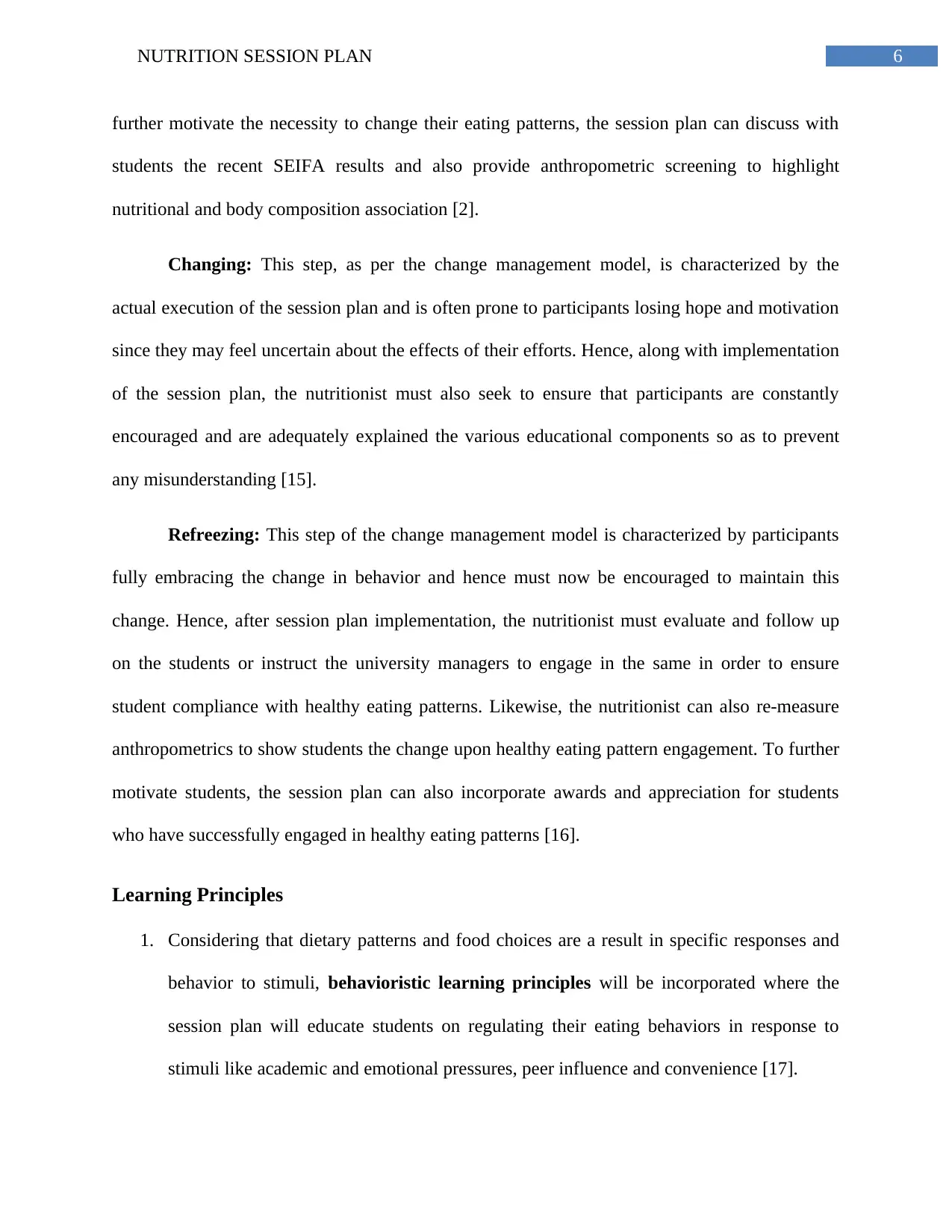
6NUTRITION SESSION PLAN
further motivate the necessity to change their eating patterns, the session plan can discuss with
students the recent SEIFA results and also provide anthropometric screening to highlight
nutritional and body composition association [2].
Changing: This step, as per the change management model, is characterized by the
actual execution of the session plan and is often prone to participants losing hope and motivation
since they may feel uncertain about the effects of their efforts. Hence, along with implementation
of the session plan, the nutritionist must also seek to ensure that participants are constantly
encouraged and are adequately explained the various educational components so as to prevent
any misunderstanding [15].
Refreezing: This step of the change management model is characterized by participants
fully embracing the change in behavior and hence must now be encouraged to maintain this
change. Hence, after session plan implementation, the nutritionist must evaluate and follow up
on the students or instruct the university managers to engage in the same in order to ensure
student compliance with healthy eating patterns. Likewise, the nutritionist can also re-measure
anthropometrics to show students the change upon healthy eating pattern engagement. To further
motivate students, the session plan can also incorporate awards and appreciation for students
who have successfully engaged in healthy eating patterns [16].
Learning Principles
1. Considering that dietary patterns and food choices are a result in specific responses and
behavior to stimuli, behavioristic learning principles will be incorporated where the
session plan will educate students on regulating their eating behaviors in response to
stimuli like academic and emotional pressures, peer influence and convenience [17].
further motivate the necessity to change their eating patterns, the session plan can discuss with
students the recent SEIFA results and also provide anthropometric screening to highlight
nutritional and body composition association [2].
Changing: This step, as per the change management model, is characterized by the
actual execution of the session plan and is often prone to participants losing hope and motivation
since they may feel uncertain about the effects of their efforts. Hence, along with implementation
of the session plan, the nutritionist must also seek to ensure that participants are constantly
encouraged and are adequately explained the various educational components so as to prevent
any misunderstanding [15].
Refreezing: This step of the change management model is characterized by participants
fully embracing the change in behavior and hence must now be encouraged to maintain this
change. Hence, after session plan implementation, the nutritionist must evaluate and follow up
on the students or instruct the university managers to engage in the same in order to ensure
student compliance with healthy eating patterns. Likewise, the nutritionist can also re-measure
anthropometrics to show students the change upon healthy eating pattern engagement. To further
motivate students, the session plan can also incorporate awards and appreciation for students
who have successfully engaged in healthy eating patterns [16].
Learning Principles
1. Considering that dietary patterns and food choices are a result in specific responses and
behavior to stimuli, behavioristic learning principles will be incorporated where the
session plan will educate students on regulating their eating behaviors in response to
stimuli like academic and emotional pressures, peer influence and convenience [17].
Paraphrase This Document
Need a fresh take? Get an instant paraphrase of this document with our AI Paraphraser
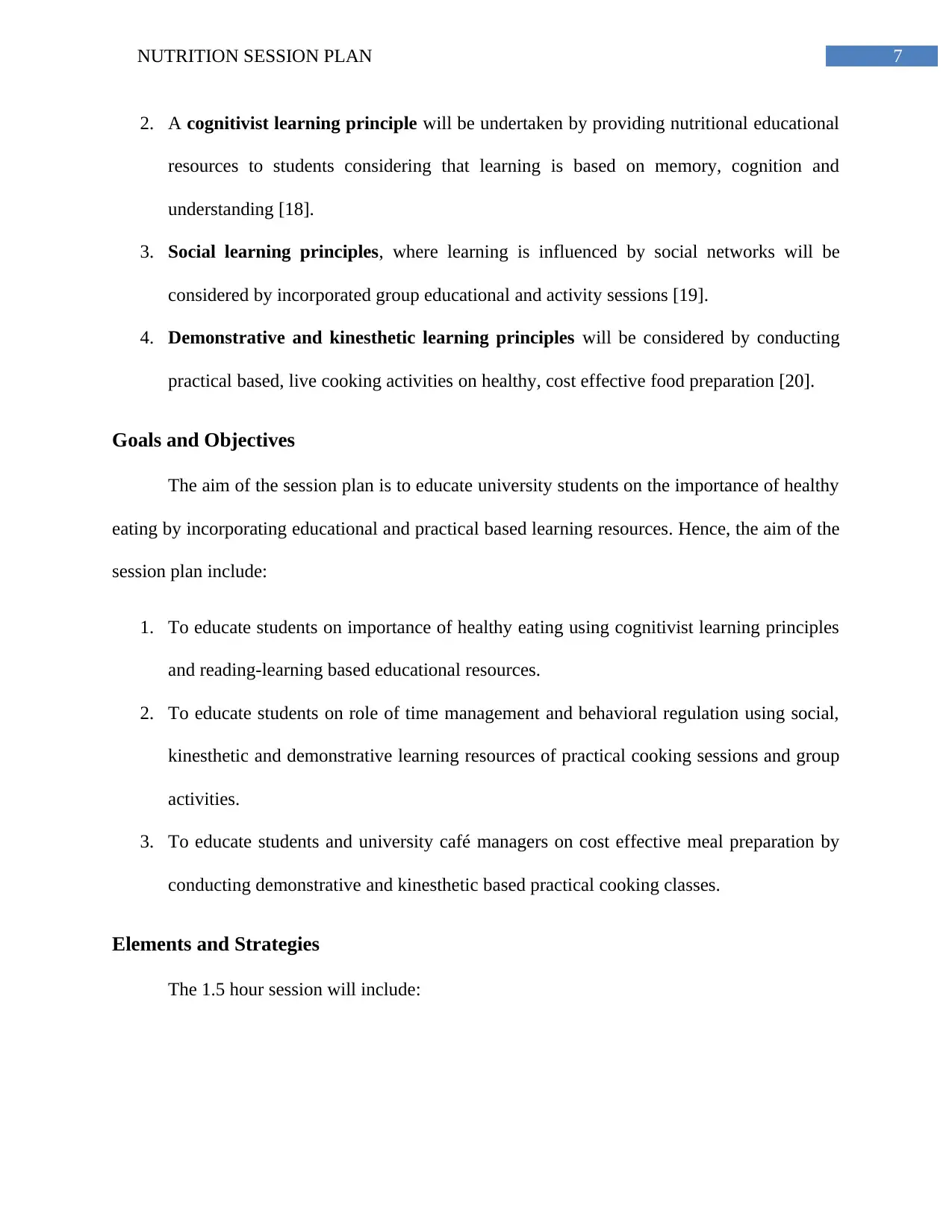
7NUTRITION SESSION PLAN
2. A cognitivist learning principle will be undertaken by providing nutritional educational
resources to students considering that learning is based on memory, cognition and
understanding [18].
3. Social learning principles, where learning is influenced by social networks will be
considered by incorporated group educational and activity sessions [19].
4. Demonstrative and kinesthetic learning principles will be considered by conducting
practical based, live cooking activities on healthy, cost effective food preparation [20].
Goals and Objectives
The aim of the session plan is to educate university students on the importance of healthy
eating by incorporating educational and practical based learning resources. Hence, the aim of the
session plan include:
1. To educate students on importance of healthy eating using cognitivist learning principles
and reading-learning based educational resources.
2. To educate students on role of time management and behavioral regulation using social,
kinesthetic and demonstrative learning resources of practical cooking sessions and group
activities.
3. To educate students and university café managers on cost effective meal preparation by
conducting demonstrative and kinesthetic based practical cooking classes.
Elements and Strategies
The 1.5 hour session will include:
2. A cognitivist learning principle will be undertaken by providing nutritional educational
resources to students considering that learning is based on memory, cognition and
understanding [18].
3. Social learning principles, where learning is influenced by social networks will be
considered by incorporated group educational and activity sessions [19].
4. Demonstrative and kinesthetic learning principles will be considered by conducting
practical based, live cooking activities on healthy, cost effective food preparation [20].
Goals and Objectives
The aim of the session plan is to educate university students on the importance of healthy
eating by incorporating educational and practical based learning resources. Hence, the aim of the
session plan include:
1. To educate students on importance of healthy eating using cognitivist learning principles
and reading-learning based educational resources.
2. To educate students on role of time management and behavioral regulation using social,
kinesthetic and demonstrative learning resources of practical cooking sessions and group
activities.
3. To educate students and university café managers on cost effective meal preparation by
conducting demonstrative and kinesthetic based practical cooking classes.
Elements and Strategies
The 1.5 hour session will include:
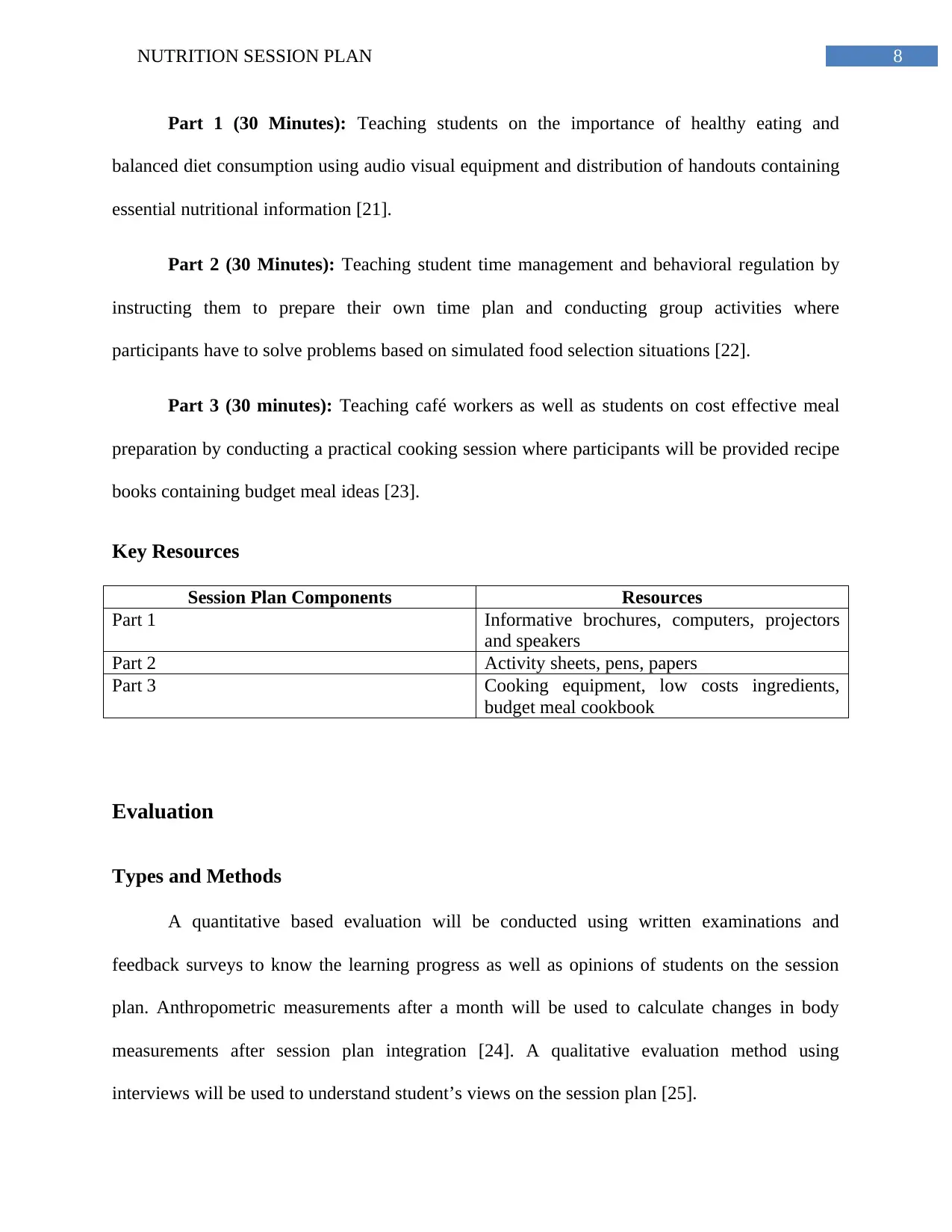
8NUTRITION SESSION PLAN
Part 1 (30 Minutes): Teaching students on the importance of healthy eating and
balanced diet consumption using audio visual equipment and distribution of handouts containing
essential nutritional information [21].
Part 2 (30 Minutes): Teaching student time management and behavioral regulation by
instructing them to prepare their own time plan and conducting group activities where
participants have to solve problems based on simulated food selection situations [22].
Part 3 (30 minutes): Teaching café workers as well as students on cost effective meal
preparation by conducting a practical cooking session where participants will be provided recipe
books containing budget meal ideas [23].
Key Resources
Session Plan Components Resources
Part 1 Informative brochures, computers, projectors
and speakers
Part 2 Activity sheets, pens, papers
Part 3 Cooking equipment, low costs ingredients,
budget meal cookbook
Evaluation
Types and Methods
A quantitative based evaluation will be conducted using written examinations and
feedback surveys to know the learning progress as well as opinions of students on the session
plan. Anthropometric measurements after a month will be used to calculate changes in body
measurements after session plan integration [24]. A qualitative evaluation method using
interviews will be used to understand student’s views on the session plan [25].
Part 1 (30 Minutes): Teaching students on the importance of healthy eating and
balanced diet consumption using audio visual equipment and distribution of handouts containing
essential nutritional information [21].
Part 2 (30 Minutes): Teaching student time management and behavioral regulation by
instructing them to prepare their own time plan and conducting group activities where
participants have to solve problems based on simulated food selection situations [22].
Part 3 (30 minutes): Teaching café workers as well as students on cost effective meal
preparation by conducting a practical cooking session where participants will be provided recipe
books containing budget meal ideas [23].
Key Resources
Session Plan Components Resources
Part 1 Informative brochures, computers, projectors
and speakers
Part 2 Activity sheets, pens, papers
Part 3 Cooking equipment, low costs ingredients,
budget meal cookbook
Evaluation
Types and Methods
A quantitative based evaluation will be conducted using written examinations and
feedback surveys to know the learning progress as well as opinions of students on the session
plan. Anthropometric measurements after a month will be used to calculate changes in body
measurements after session plan integration [24]. A qualitative evaluation method using
interviews will be used to understand student’s views on the session plan [25].
⊘ This is a preview!⊘
Do you want full access?
Subscribe today to unlock all pages.

Trusted by 1+ million students worldwide
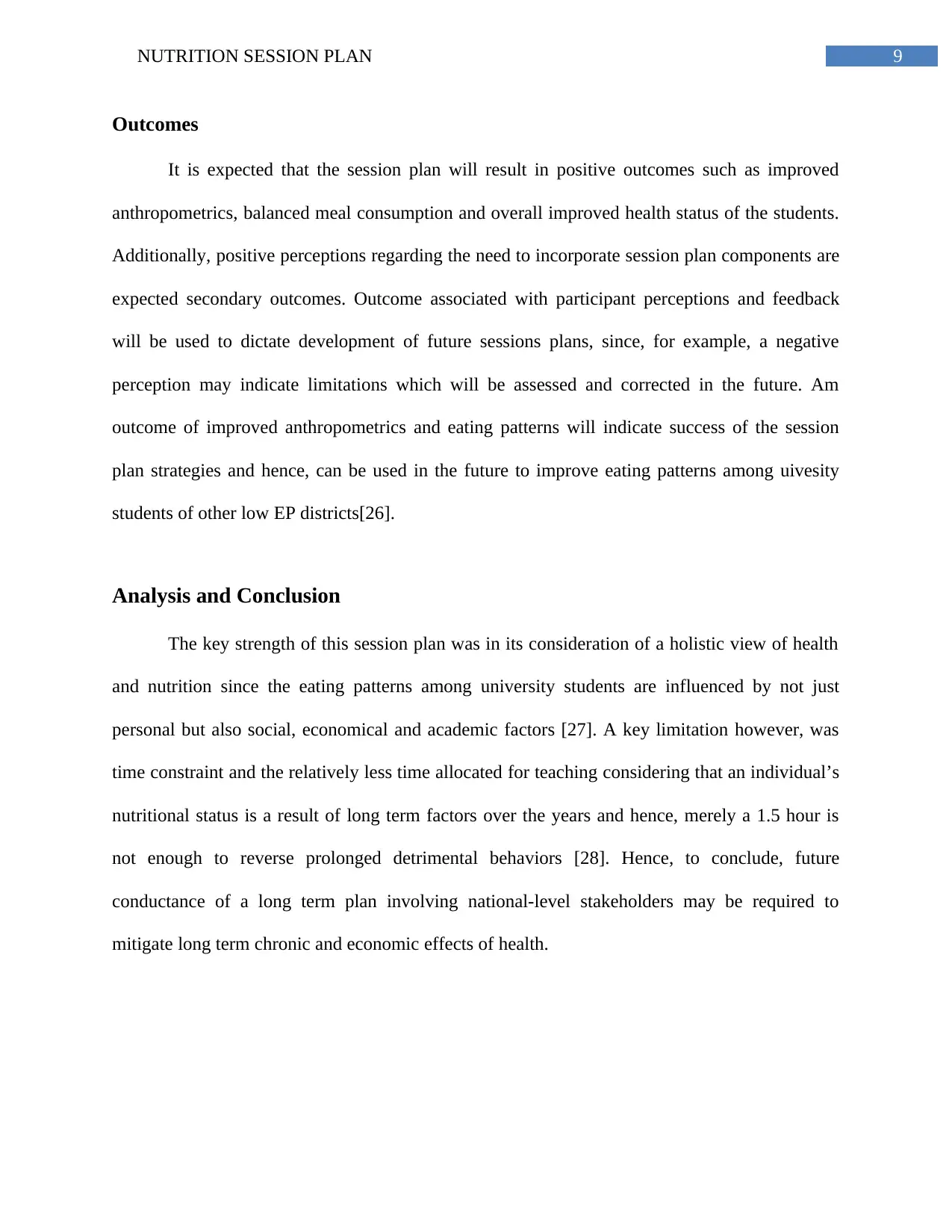
9NUTRITION SESSION PLAN
Outcomes
It is expected that the session plan will result in positive outcomes such as improved
anthropometrics, balanced meal consumption and overall improved health status of the students.
Additionally, positive perceptions regarding the need to incorporate session plan components are
expected secondary outcomes. Outcome associated with participant perceptions and feedback
will be used to dictate development of future sessions plans, since, for example, a negative
perception may indicate limitations which will be assessed and corrected in the future. Am
outcome of improved anthropometrics and eating patterns will indicate success of the session
plan strategies and hence, can be used in the future to improve eating patterns among uivesity
students of other low EP districts[26].
Analysis and Conclusion
The key strength of this session plan was in its consideration of a holistic view of health
and nutrition since the eating patterns among university students are influenced by not just
personal but also social, economical and academic factors [27]. A key limitation however, was
time constraint and the relatively less time allocated for teaching considering that an individual’s
nutritional status is a result of long term factors over the years and hence, merely a 1.5 hour is
not enough to reverse prolonged detrimental behaviors [28]. Hence, to conclude, future
conductance of a long term plan involving national-level stakeholders may be required to
mitigate long term chronic and economic effects of health.
Outcomes
It is expected that the session plan will result in positive outcomes such as improved
anthropometrics, balanced meal consumption and overall improved health status of the students.
Additionally, positive perceptions regarding the need to incorporate session plan components are
expected secondary outcomes. Outcome associated with participant perceptions and feedback
will be used to dictate development of future sessions plans, since, for example, a negative
perception may indicate limitations which will be assessed and corrected in the future. Am
outcome of improved anthropometrics and eating patterns will indicate success of the session
plan strategies and hence, can be used in the future to improve eating patterns among uivesity
students of other low EP districts[26].
Analysis and Conclusion
The key strength of this session plan was in its consideration of a holistic view of health
and nutrition since the eating patterns among university students are influenced by not just
personal but also social, economical and academic factors [27]. A key limitation however, was
time constraint and the relatively less time allocated for teaching considering that an individual’s
nutritional status is a result of long term factors over the years and hence, merely a 1.5 hour is
not enough to reverse prolonged detrimental behaviors [28]. Hence, to conclude, future
conductance of a long term plan involving national-level stakeholders may be required to
mitigate long term chronic and economic effects of health.
Paraphrase This Document
Need a fresh take? Get an instant paraphrase of this document with our AI Paraphraser
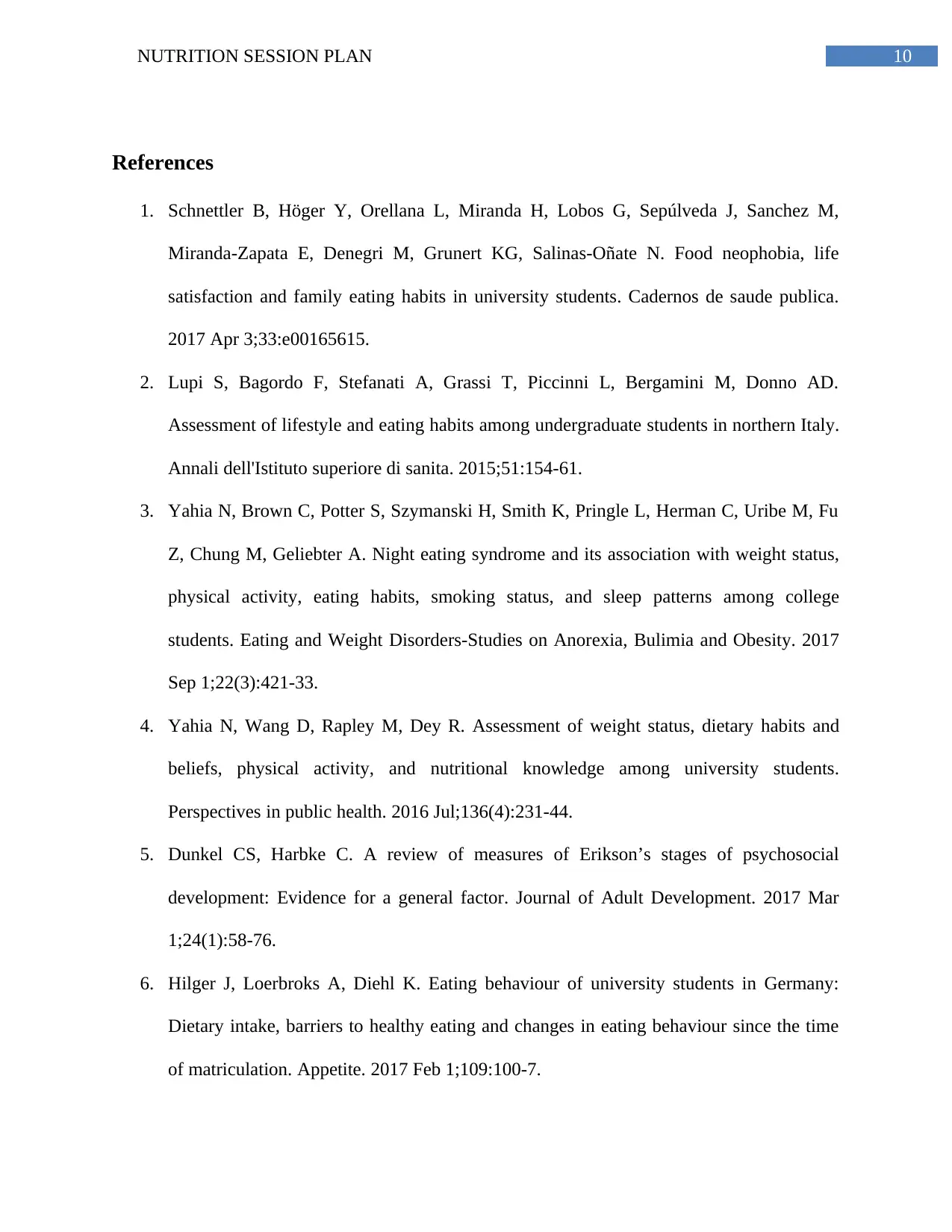
10NUTRITION SESSION PLAN
References
1. Schnettler B, Höger Y, Orellana L, Miranda H, Lobos G, Sepúlveda J, Sanchez M,
Miranda-Zapata E, Denegri M, Grunert KG, Salinas-Oñate N. Food neophobia, life
satisfaction and family eating habits in university students. Cadernos de saude publica.
2017 Apr 3;33:e00165615.
2. Lupi S, Bagordo F, Stefanati A, Grassi T, Piccinni L, Bergamini M, Donno AD.
Assessment of lifestyle and eating habits among undergraduate students in northern Italy.
Annali dell'Istituto superiore di sanita. 2015;51:154-61.
3. Yahia N, Brown C, Potter S, Szymanski H, Smith K, Pringle L, Herman C, Uribe M, Fu
Z, Chung M, Geliebter A. Night eating syndrome and its association with weight status,
physical activity, eating habits, smoking status, and sleep patterns among college
students. Eating and Weight Disorders-Studies on Anorexia, Bulimia and Obesity. 2017
Sep 1;22(3):421-33.
4. Yahia N, Wang D, Rapley M, Dey R. Assessment of weight status, dietary habits and
beliefs, physical activity, and nutritional knowledge among university students.
Perspectives in public health. 2016 Jul;136(4):231-44.
5. Dunkel CS, Harbke C. A review of measures of Erikson’s stages of psychosocial
development: Evidence for a general factor. Journal of Adult Development. 2017 Mar
1;24(1):58-76.
6. Hilger J, Loerbroks A, Diehl K. Eating behaviour of university students in Germany:
Dietary intake, barriers to healthy eating and changes in eating behaviour since the time
of matriculation. Appetite. 2017 Feb 1;109:100-7.
References
1. Schnettler B, Höger Y, Orellana L, Miranda H, Lobos G, Sepúlveda J, Sanchez M,
Miranda-Zapata E, Denegri M, Grunert KG, Salinas-Oñate N. Food neophobia, life
satisfaction and family eating habits in university students. Cadernos de saude publica.
2017 Apr 3;33:e00165615.
2. Lupi S, Bagordo F, Stefanati A, Grassi T, Piccinni L, Bergamini M, Donno AD.
Assessment of lifestyle and eating habits among undergraduate students in northern Italy.
Annali dell'Istituto superiore di sanita. 2015;51:154-61.
3. Yahia N, Brown C, Potter S, Szymanski H, Smith K, Pringle L, Herman C, Uribe M, Fu
Z, Chung M, Geliebter A. Night eating syndrome and its association with weight status,
physical activity, eating habits, smoking status, and sleep patterns among college
students. Eating and Weight Disorders-Studies on Anorexia, Bulimia and Obesity. 2017
Sep 1;22(3):421-33.
4. Yahia N, Wang D, Rapley M, Dey R. Assessment of weight status, dietary habits and
beliefs, physical activity, and nutritional knowledge among university students.
Perspectives in public health. 2016 Jul;136(4):231-44.
5. Dunkel CS, Harbke C. A review of measures of Erikson’s stages of psychosocial
development: Evidence for a general factor. Journal of Adult Development. 2017 Mar
1;24(1):58-76.
6. Hilger J, Loerbroks A, Diehl K. Eating behaviour of university students in Germany:
Dietary intake, barriers to healthy eating and changes in eating behaviour since the time
of matriculation. Appetite. 2017 Feb 1;109:100-7.
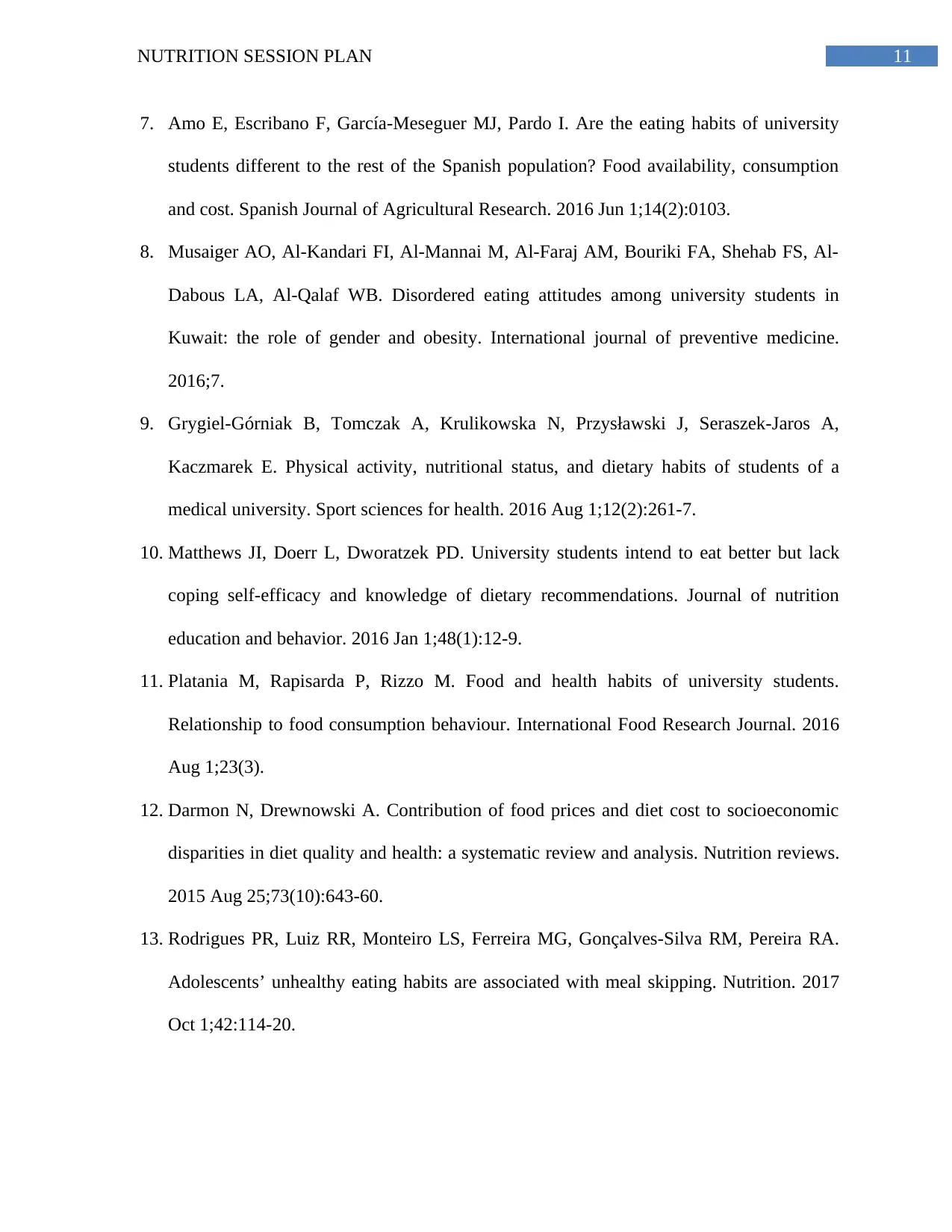
11NUTRITION SESSION PLAN
7. Amo E, Escribano F, García-Meseguer MJ, Pardo I. Are the eating habits of university
students different to the rest of the Spanish population? Food availability, consumption
and cost. Spanish Journal of Agricultural Research. 2016 Jun 1;14(2):0103.
8. Musaiger AO, Al-Kandari FI, Al-Mannai M, Al-Faraj AM, Bouriki FA, Shehab FS, Al-
Dabous LA, Al-Qalaf WB. Disordered eating attitudes among university students in
Kuwait: the role of gender and obesity. International journal of preventive medicine.
2016;7.
9. Grygiel-Górniak B, Tomczak A, Krulikowska N, Przysławski J, Seraszek-Jaros A,
Kaczmarek E. Physical activity, nutritional status, and dietary habits of students of a
medical university. Sport sciences for health. 2016 Aug 1;12(2):261-7.
10. Matthews JI, Doerr L, Dworatzek PD. University students intend to eat better but lack
coping self-efficacy and knowledge of dietary recommendations. Journal of nutrition
education and behavior. 2016 Jan 1;48(1):12-9.
11. Platania M, Rapisarda P, Rizzo M. Food and health habits of university students.
Relationship to food consumption behaviour. International Food Research Journal. 2016
Aug 1;23(3).
12. Darmon N, Drewnowski A. Contribution of food prices and diet cost to socioeconomic
disparities in diet quality and health: a systematic review and analysis. Nutrition reviews.
2015 Aug 25;73(10):643-60.
13. Rodrigues PR, Luiz RR, Monteiro LS, Ferreira MG, Gonçalves-Silva RM, Pereira RA.
Adolescents’ unhealthy eating habits are associated with meal skipping. Nutrition. 2017
Oct 1;42:114-20.
7. Amo E, Escribano F, García-Meseguer MJ, Pardo I. Are the eating habits of university
students different to the rest of the Spanish population? Food availability, consumption
and cost. Spanish Journal of Agricultural Research. 2016 Jun 1;14(2):0103.
8. Musaiger AO, Al-Kandari FI, Al-Mannai M, Al-Faraj AM, Bouriki FA, Shehab FS, Al-
Dabous LA, Al-Qalaf WB. Disordered eating attitudes among university students in
Kuwait: the role of gender and obesity. International journal of preventive medicine.
2016;7.
9. Grygiel-Górniak B, Tomczak A, Krulikowska N, Przysławski J, Seraszek-Jaros A,
Kaczmarek E. Physical activity, nutritional status, and dietary habits of students of a
medical university. Sport sciences for health. 2016 Aug 1;12(2):261-7.
10. Matthews JI, Doerr L, Dworatzek PD. University students intend to eat better but lack
coping self-efficacy and knowledge of dietary recommendations. Journal of nutrition
education and behavior. 2016 Jan 1;48(1):12-9.
11. Platania M, Rapisarda P, Rizzo M. Food and health habits of university students.
Relationship to food consumption behaviour. International Food Research Journal. 2016
Aug 1;23(3).
12. Darmon N, Drewnowski A. Contribution of food prices and diet cost to socioeconomic
disparities in diet quality and health: a systematic review and analysis. Nutrition reviews.
2015 Aug 25;73(10):643-60.
13. Rodrigues PR, Luiz RR, Monteiro LS, Ferreira MG, Gonçalves-Silva RM, Pereira RA.
Adolescents’ unhealthy eating habits are associated with meal skipping. Nutrition. 2017
Oct 1;42:114-20.
⊘ This is a preview!⊘
Do you want full access?
Subscribe today to unlock all pages.

Trusted by 1+ million students worldwide
1 out of 14
Related Documents
Your All-in-One AI-Powered Toolkit for Academic Success.
+13062052269
info@desklib.com
Available 24*7 on WhatsApp / Email
![[object Object]](/_next/static/media/star-bottom.7253800d.svg)
Unlock your academic potential
Copyright © 2020–2025 A2Z Services. All Rights Reserved. Developed and managed by ZUCOL.





